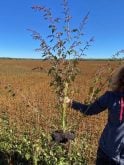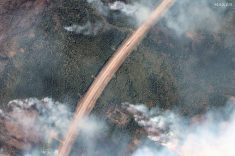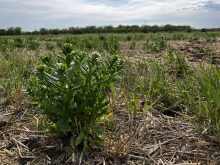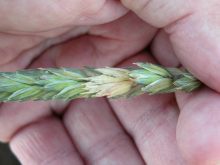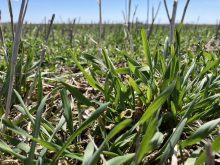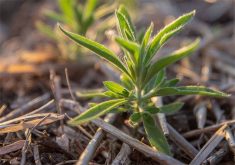Producers may be looking for a way to beat back kochia, but what does that mean for the salinity problems lurking in the soil?
Saline patches were common this year after a second season of below-average moisture.
- Read more: The year of the tumbleweed
“The fluctuations in soil moisture are very linked to the soil salinity,” provincial soil management specialist Marla Riekman said during a late-September Crop Talk webinar.
Read Also

CUSMA access key among other trade noise: Seeds Canada panel
Seeds Canada conference panelists say Canada needs to stay focused and wait as U.S. trade and tariff chaos develops, and a Canada-U.S.-Mexico Agreement review looms
She said precipitation will leach salts down in a wet year, but then get caught in the high water table close to the surface and remain when groundwater levels drop.
“As we go into some dry years, that’s where the salinity becomes a problem. Now you have this high water table, that capillary rise or wicking effect is drawing those salts and the water up towards the root zone.”
Much of Manitoba had that process first hand this year. The resulting salinity also contributed to a rise in kochia, said Manitoba Agriculture weed specialist Tammy Jones. There were widespread complaints of the saline-tolerant weed, which also thrives in hot, dry weather.
Green but noxious
The dual problem has growers scratching their heads on how to eliminate the weed while also drawing down salts, something that experts like Riekman say is more easily done by maintaining green cover to increase infiltration.
On one hand, kochia itself is green cover on land where salinity makes it difficult to establish another crop. At the same time, the weed is infamous for its prolific spread, along with growing resistance concerns.
It’s a big question, said Craig Allison, senior agronomist and associate manager at Redfern Farm Services in Rivers. Remedial strategies like elemental sulphur may help cope with salinity but do not touch internal drainage problems that he says will keep the problem coming back.
Allison suggests that to control both problems, it may be time to return saline areas near sloughs to grass, therefore adding a perennial green cover which can be mowed through the season to keep the kochia in check.
“Kochia, it’s a big plant. It looks really aggressive, but it really isn’t in comparison to an aggressive crop,” Allison said. “If we can get something else growing in there… but you’re mowing your ‘lawn’ before kochia even starts germinating and you’re still typically mowing your lawn once kochia is kind of done its life cycle.”
Riekman agreed. “It’s sucking more water because it’s consistently in a vegetative state through that mowing and, because they’re extracting water, they’re actually decreasing the amount of salinity, because the water table is dropping away.”
Allison said some customers also swathed and gathered kochia for burning this year, which removes biomass and limits snow catch in low areas but also drops many of the seeds the farmer hopes to eliminate. Dry conditions also restricted burning in parts of the province this year, he added.
Chemical control
For controlling kochia with chemicals, both Jones and Allison warned to look past glyphosate and to add multiple modes of action to the tank. Glyphosate-resistant kochia has become a particular concern in Manitoba, and Jones expects more municipalities will have reported the problem after this year.
“Also acknowledge that if you had a kochia patch and you combined it, you probably blew viable seed out the back of the combine, so think about how you’re managing it next year as well,” Jones warned. “That might mean adjusting your crop rotation to make sure you’ve got a crop in there that you can use different modes of action on the kochia or you might want to be looking at either a fall application of one of the extended control chemistries, a Group 14 or a Group 15, or a spring application of one of those pre-emerge herbicides.”
Don’t fertilize the problem
Riekman said farmers looking to plow down their weed patches may run into trouble with salinity management, and she urged them to stop tilling and adding inputs to saline areas, which are currently not productive anyway.
“The reason that tilling saline patches makes it worse is that what you’re doing is increasing the evaporation of water from that soil surface by tilling it under, making it black, and as you increase evaporation, you actually draw more water up from that water table, so you draw more soil salts to the surface,” she said.
Allison has a different take on tillage risk. He agreed it could cause more harm than good in a wet year, allowing greater evaporation and water wicking upwards. But he argued that in dry years, fluffing the topsoil may help infiltration in certain soil types, assuming fall rains.
“Those soils are inherently high in magnesium. They’re a very tight soil and so what they will do is, if they aren’t worked, they’ll actually seal off,” he said. “What rain and moisture that you do typically get will kind of hit and then run off. With salinity, you actually do want to till in dry years because what you’ll do is you’ll allow more moisture to actually be absorbed into the soil system and actually flush the salts down to a lower depth.”
Kochia can be managed once those salts are down, Allison added.
“It’s not a single solution,” he said. “Sometimes tillage is a good thing. Sometimes tillage is a bad thing. Sometimes chemical and too much chemical is definitely a bad thing, but trying to do it without chemical is also a bad thing, because then you’re relying too much on tillage, which is sometimes a yes and sometimes a no.”








